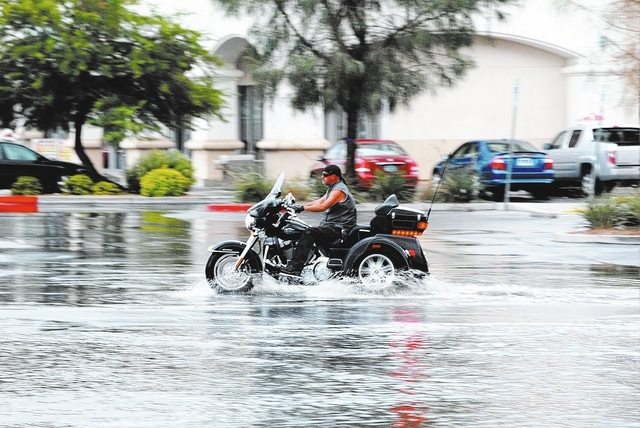
The Mojave Desert climate can result in wide temperature swings, which this year varied from 115 degree highs at the end of June and early July to a low of 18 degrees in mid-January and December 2013.
The Desert Research Institute weather station in Pahrump logged a high temperature of 112 degrees June 28, 115 degrees June 29 and June 30, then 114 degrees July 1, 113 degrees on both July 2-3 and 112 degrees July 4.
“We just had a humongous area of high pressure that moved over and sat overhead for about a week, just a very, very, hot air mass,” National Weather Service Meteorologist Clay Morgan said. “The main problem with this one was the duration.”
Early July is normally the hottest time of the year in Pahrump, but average highs only get up to 100 to 101 degrees and overnight lows dip to 69 degrees according to 30-year averages. The mercury only dipped down to 88 degrees July 1.
The heat resulted in 600 dead or injured in southern Nevada, northwest Arizona and southeastern California, he said. It even knocked out phone and Internet service in Lake Havasu City, Ariz.
After the buildup of the summer heat came the rains.
The year was characterized by an unusual summer monsoon season, with most of the rain dumped on the Las Vegas side of the Spring Mountains and only cloudy afternoons with threatening rain on the Pahrump side, but it lasted for many afternoons in July and August. There were a few exceptions, like a July 28 deluge in Pahrump, a weather spotter reported two inches of rain fell in an hour and a half that day, Morgan said, flooding some streets with water up to three feet deep. Twenty people had to be rescued by the Pahrump Valley Fire and Rescue Service. The Desert Research Institute recording station logged .32 inches of rain July 27 and a half-inch July 28.
Just over a week before that, wind gusts were clocked at up to 80 mph on July 20, uprooting trees, downing power lines and scattering debris throughout the Pahrump Valley.
While Pahrump didn’t get a lot of rain Aug. 30, the summer monsoons over the Spring Mountains caused the closure of a section of Highway 160 near the Tecopa Road on Aug. 30, due to mud flows down Trout Canyon following the Carpenter One fire in July.
“It’s common for the heaviest stuff to fall over the mountains because the mountains have to lift the air,” Morgan said. When the summer monsoon wind comes from the east, it tends to dump rain on the Las Vegas side of the mountains, he said, when it comes from the west, Pahrump will get the rainfall.
The cold snaps in January and December were bookends around the torrid heat of July. Morgan said a cold air mass plunged down from Canada both times. He said normally the Rocky Mountains protect southern Nevada from a lot of very cold air diving down from Canada into the eastern U.S. during the winter.
From Jan. 12-16 a deep freeze set in, the temperature dropped to 19 degrees Jan. 13 and 18 degrees Jan. 14, only rising to a high of 40 degrees Jan. 12. The normal high for that period is 60 degrees and the normal low 33. That caused an estimated damage of $125,000 in the Pahrump area, Morgan said, from things like bursting pipes. The fact temperatures didn’t rise much for a couple days made the pipes freeze harder, he said.
The last sub-freezing day of the 2012-13 winter was the 31-degree readings the last three days of February according to the DRI weather station. On March 14 the mercury soared to 88 degrees and 89 degrees the next day.
Pahrump logged its first 100-degree day June 1, the last day of triple digit heat was Sept. 16.
During the latest cold spell, Dec. 8-12, the mercury again fell to 18 degrees overnight on Dec. 10, there were lows of 22 degrees Dec. 11 and 24 degrees Dec. 12. The temperature only rose to 43 degrees Dec. 8 and 40 degrees Dec. 9. The normal high in Pahrump for that period is 46 degrees, the average low is 27.
The rainfall numbers are below average for 2013. Morgan didn’t have yearly 2013 totals for Pahrump, but he said the year-to-date rainfall in Las Vegas is only 2.96 inches, down 1.11 inches from the norm of 4.07 inches.
The DRI rain gauge tallied .22 inch in November; almost all of the .14 inch in October fell Oct. 9; July was the wettest month with .87 inch and .63 inch fell in January. In May and June the DRI didn’t record any rain in Pahrump, while only .04 inch fell in February, and .03 inch fell in April, March and August.